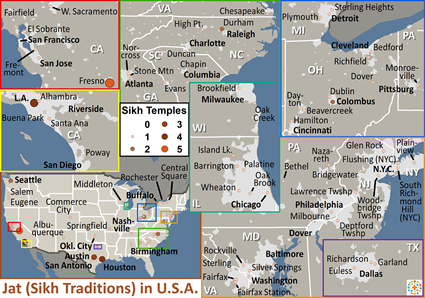There are different opinions as to the origin of the Jats, but most seem to recognize them to be from Indo-Aryan tribes native to the Punjab region that straddles modern Pakistan and India. There is a theory suggesting that they may be the predecessors of Gypsies. They probably reached Egypt with the Muslim conquerors, lived in Afghanistan before the Muslims, and invaded China with the Mongol Army. They also proved to be a threat to Tamarlane in Persia and Uzbekistan in the 1400s.
There are very few records concerning Jats prior to the 1600s. They rose to prominence following the 1669 Jat uprising against Mughal rule, and they ruled various princely states throughout the 18th century. For centuries the Jat lifestyle was designed to foster a martial spirit. Whenever they lost their kingdoms, Jat people became landlords who were ready to defend their land against any invaders.
After 1858, under the British Raj, the Jats were known for their service in the Indian Army, being categorized as a "martial race" by the British. For a couple hundred years Jats were a force that could not be ignored by South Asians or British imperialists.
The first Jat Sikhs arrived in the United States in the second half of the 19th century. At that time, they were driven out of their South Asian homeland by poor economic conditions. Their skills in agriculture were useful in their new homeland. However, most became urban, and today the Jat Sikhs in the United States are likely to be found in New York or New Jersey. There are Jat Sikhs in California's rural Central Valley. They live as far south as Bakersfield and as far north as Yuba City. Others are truck drivers who live in various western states.
Jat Sikhs are well represented in many areas of American life. They have found success as farmers in California's Central Valley and as businessmen or medical personnel in urban areas. They often drive cabs in New York City. There are so many Sikh truck drivers that one can find Punjabi text on the sides of trucks taking merchandise and produce to various parts of the country. The Jats have a strong military tradition; some have joined American military institutions and police forces. There have been conflicts where either military or police regulations conflict with the Sikh requirement to have a beard and to wear a turban. These issues come up from time to time, and they often wind up in court.
Like many second generation immigrants, the Jat Sikhs are trying to maintain the old culture in a foreign environment. For this reason, they often send their children to special Sikh schools. The children learn Sikh history, culture, and the Punjabi language. Though they are united in their Sikh religion, these efforts are usually at the local level.
Sikhism originated from a 15th century teacher named Guru Nanak Dev as a reform movement. He rejected the Hindu caste system, taught that all people were equal and that all have equal access to God. The Sikh God is formless, without gender and is to be found in everyone. One gets closer to God by living a good life and by practicing charity. Like Hindus, Sikhs believe in reincarnation and the law of karma; you reap what you sow in your previous life. Like Muslims, the Sikhs worship only one God.
One may recognize a Sikh man by his distinctive turban. All the 10 great Sikh gurus wore turbans. Sikh teaching mandates that a person not cut his or her hair. They worship their holy book, the Granth Sahib, which is a collection of hymns.
There are roughly the same number of Sikhs as there are Jews in the world, but Sikhs are most concentrated in Punjab, their homeland. However, you will find smaller numbers of Sikhs all over the world. Many of the best Indian restaurants in the West are owned and operated by Sikhs.
The Jat Sikh people need to put their hope in the King of kings, realizing that he is the one who gives them worth and dignity.
Pray for loving workers to go to the Jat people in the US until there are disciples who make more disciples.
Pray the Lord will prepare the hearts of the Jat Sikhs to understand and to believe the gospel.
Pray for the Lord to bless the Jat people with adequate education and medical facilities.
Pray for the Lord to bless the Jat people so abundantly that they will see he is the only one worthy of praise and worship.
Scripture Prayers for the Jat (Sikh traditions) in United States.
https://en.wikipedia.org/wiki/Sikhs_in_the_United_States_military
| Profile Source: Joshua Project |


























